PoNS review: good & bad news for a new MS treatment
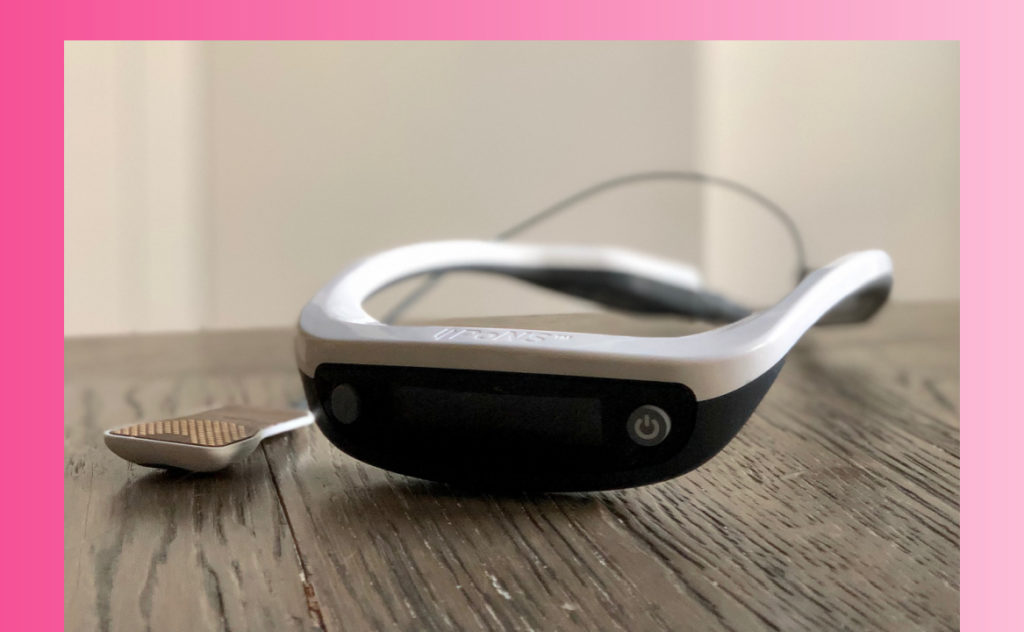
PoNS review: the good and the gutting news about a new treatment for MS progression
My trial with a new treatment for progressive MS using the PoNS device ended a few weeks ago. I’ve been late writing this review because a) I was busy filming a new tv show, and b) I’ve been waiting for some answers from Helius, the makers of the device. Okay, the delay is mostly because I’ve been waiting to hear from Helius, but get used to me casually mentioning that I have a new show coming that features the bad-assery of the disability community because omg you guys, I have a show.
But first, my PoNS review.
It’s been a minute, so I’ll remind you that PoNS is a portable neuro-stimulation device that sits on your tongue and tries to rewire your brain when MS has messed with your neural pathways. The hope is that with the magic of neuroplasticity you can retrain your brain to walk and balance better. For more deets check my original post.
And now the PoNS review you’ve been waiting for: a diary of my 99 days in the research study and a sneak peek, anecdotal, unauthorized spoiler of my results before the science–which you should definitely read–gets published.
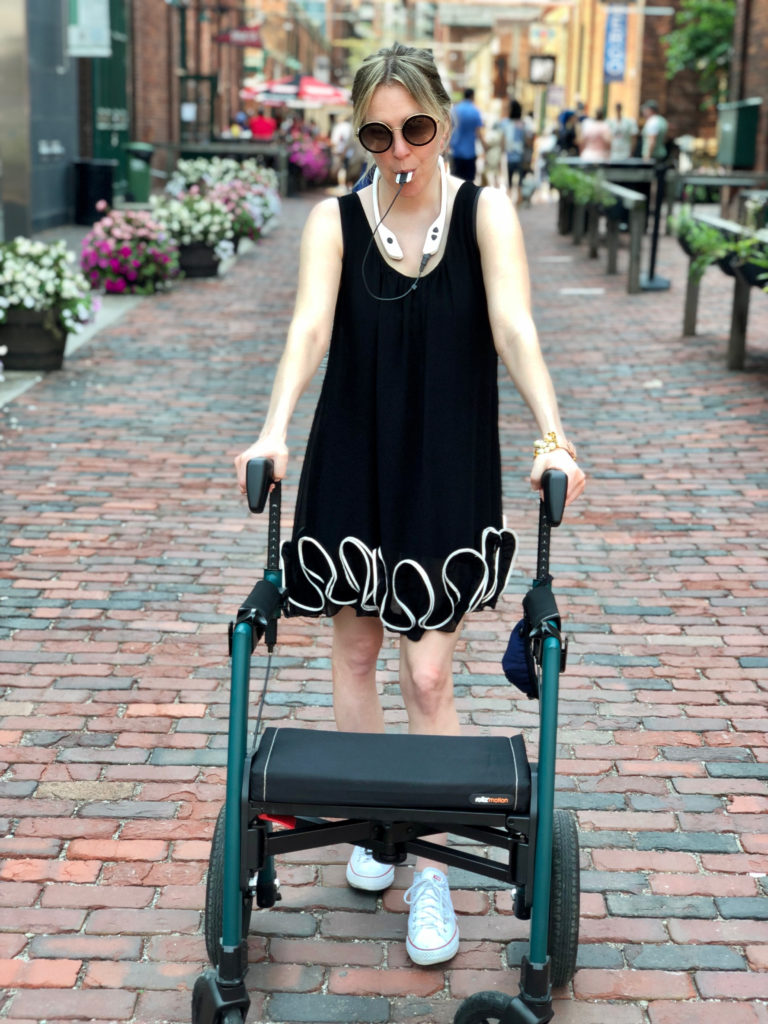
Day 1
My PoNS journey is being managed by Toronto’s Venn Med Clinic. It’s my first day and I’m feeling hopeful despite myself. I hit “publish” on a blog about the trial before heading out. Helius sees my post right away. (Is PoNS a cult? Am I being watched?) I know this because as soon as I arrive at the clinic I meet Christie, who will be coaching me throughout this journey, and learn that Helius has sent an SOS instructing her to tell me that what I’d said in my blog was wrong. I do not, in fact, get to keep the PoNS device once the study has ended.
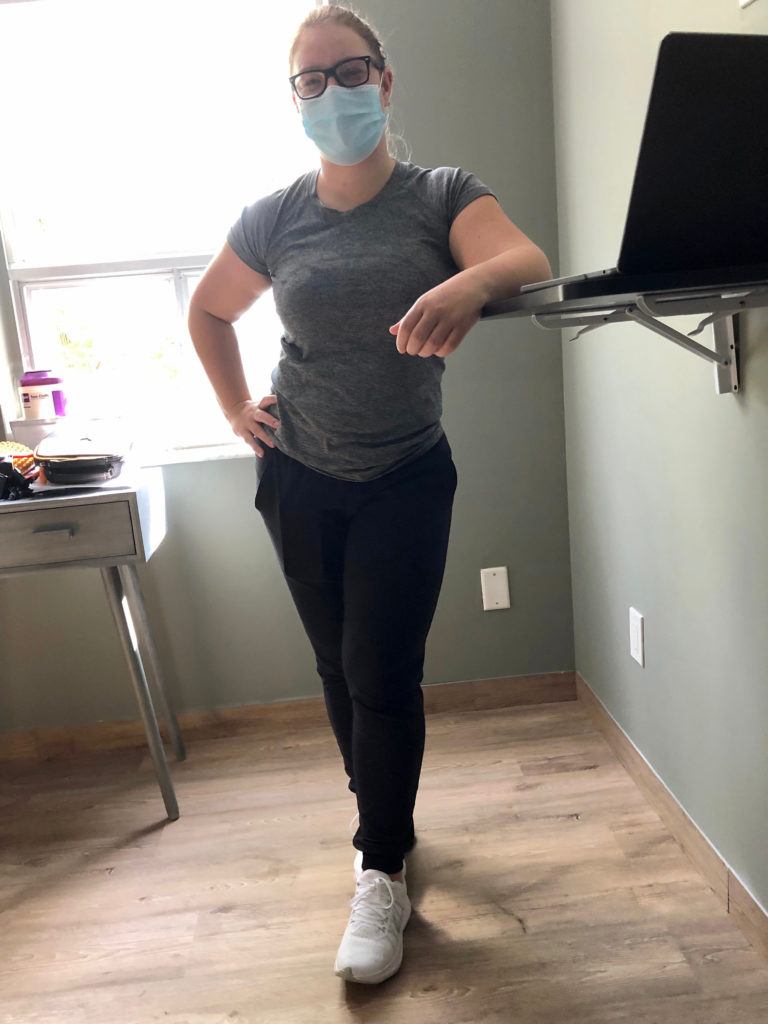
The rest of my care team includes Maria, a student, and Dr. Demien, who graciously lets everyone call him Daniel, and patiently answers my 1000 Qs, most of which are some version of “Is this really gonna help?”
For the next two weeks, I’ll spend every afternoon at the clinic, doing targeted rehab, after which appointments will drop to weekly and I’ll be required to do an hour of physio a day, on my own, for 12 weeks. This feels like a lot. Sort of. Because, how much can really change in three and a half months? 99 days is basically the lifespan of my mascara (note to self: replace your mascara), and the goal of this trial is to undo two decades of brain damage. And now it’s 98 days because we don’t actually use the device on day one. Day one is all about paperwork and intake evaluations.
The stats: my 25-foot timed walk takes 14 seconds with my rollator, and 24 seconds with a cane.
The diagnosis: slow af, but still walking.
Day 2
My first day using the PoNS. The mouthpiece is made of nickel and gold (fancy) and I’m asked if I’m allergic. This feels like a Q that should have been asked weeks ago, since anaphylaxis is kind of a dealbreaker. Fortunately, I’m only allergic to nuts, which I don’t feel too sad about, because nuts might improve heart health but they can’t do anything for my legs.
The mouthpiece is attached to a hard plastic device that sits around the neck. Rehab sessions are divided into 20 minute intervals which are counted down on a display screen that I can’t see because I don’t have eyes in the back of my head. I recognize that part of the reason PoNS is big bucks is because we’re paying for research and development; so I make another mental note to tell Helius to throw a little more R into the D, as the hard to reach on/off buttons might be tricky for anyone with dexterity issues.
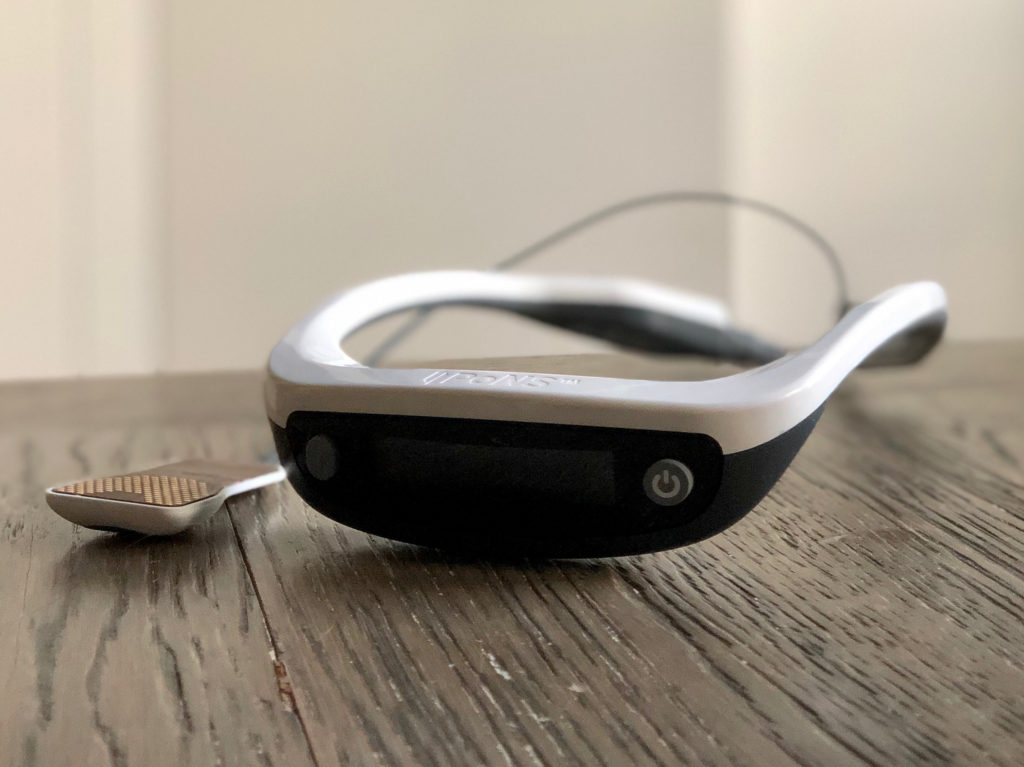
When I ask more questions about the mouthpiece, Christie casually mentions that it has to be replaced every three months to the tune of $500. Apparently Health Canada requires electrical devices that go in the mouth to have an expiry date. I probe some more. My electric toothbrush recommends I replace its mouthpiece every three months too, but I’ve been known to test these limits. Couldn’t I do the same with the PoNS?
No. The answer is no. Whether you use your mouthpiece for ten hours or two thousand, after 99 days, it’s programmed to die.
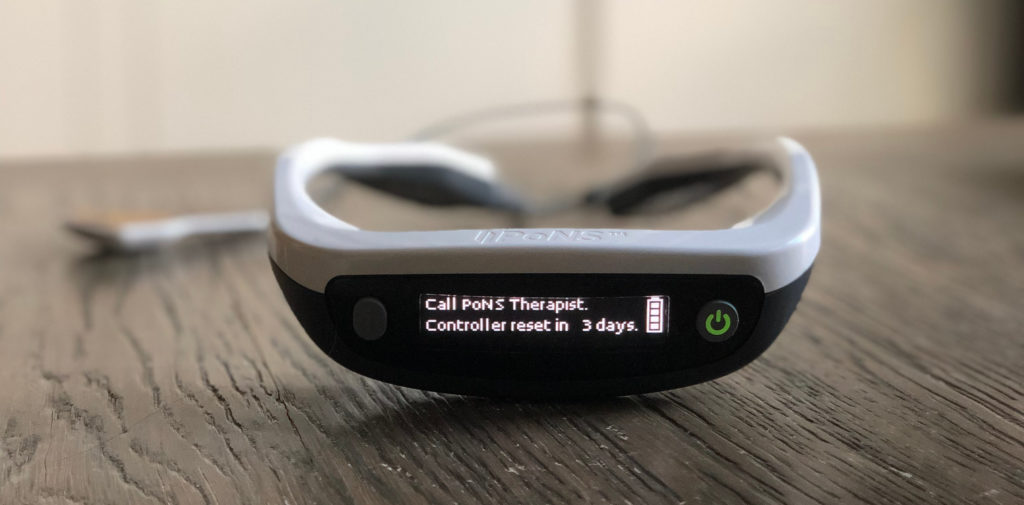
I turn on the mouthpiece and it feels vaguely like champagne bubbles on my tongue. I briefly wonder if I could just hack this process with real champagne, since that would be cheaper.
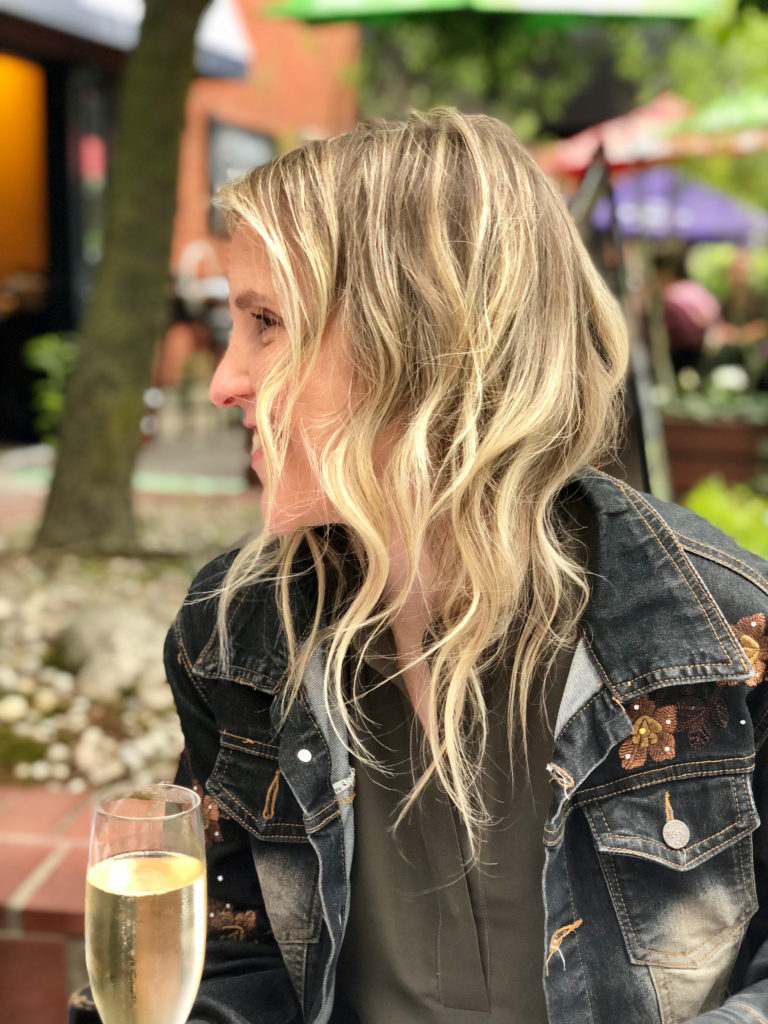
I’m still getting to know my PoNS (well, my loaner), and I ask if the battery life is similar to the suckitude of my iPhone. Christie throws me another btdubs–the device (the thing that sits around your neck that the mouthpiece plugs into)–has to be replaced every 3 years, when it Inspector Gadget-style self-destructs.
FML. Can PoNS get any more expensive? (Spoiler: It can.)
I try to put my crustiness about the cost aside. I’m introduced to electrically stimulated acupuncture, which proves to be an effective distraction. Electroacupuncture is like regular acupuncture but painful. Ish. It’s more uncomfortable than awful, and anyway, I don’t complain because I’m willing to do whatever it takes to make this shit work. (This shit: my walking.)
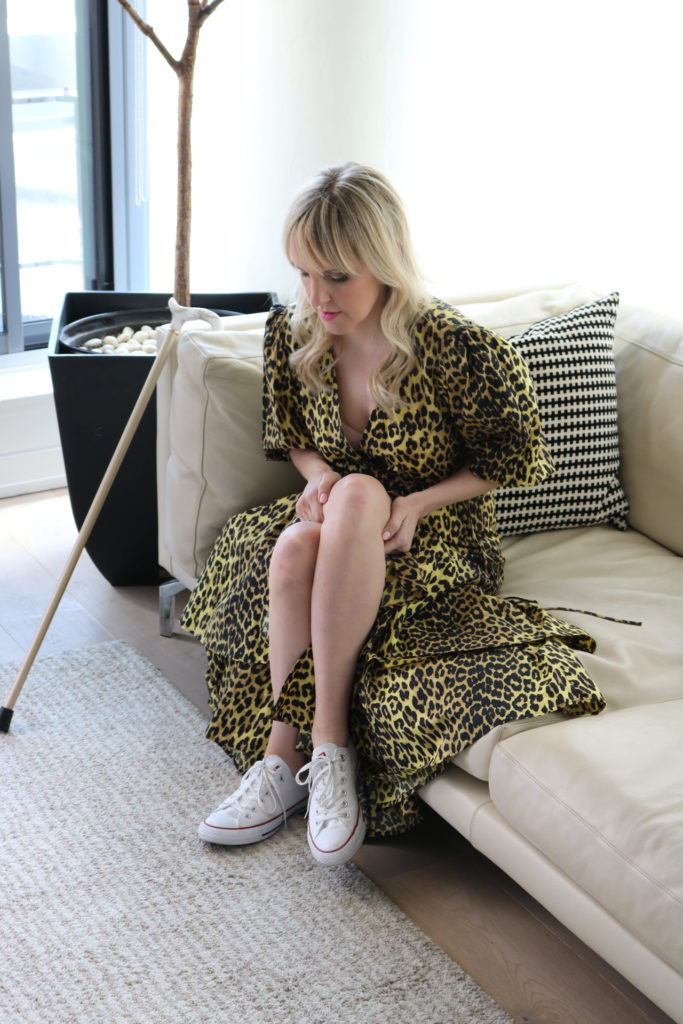
The acupuncture requires access to much of the right side of my exposed body which introduces a new layer of discomfort. I make yet another mental note not to wear period underwear tomorrow.
Sidebar: electroacupuncture is kind of a bonus of treatment at Venn Med. (I mean, it doesn’t sound like a bonus, because, ouch, but I actually think it helps.) You may not receive electroacupuncture as part of your PoNS therapy. Then again, you could seek treatment with electroacupuncture independent of PoNS therapy, but that’s a post for another day.
Day 3
I wear a shirt dress that barely covers my bum because it feels like the easiest way to provide lower body acupuncture access. It’s not like Venn Med is giving out paper gowns. The room gets the full show and in hindsight, I should have worn shorts but I don’t own any. I have no bum and I’m always bloated. I don’t do shorts.
Christie tells me she sees encouraging signs, but I don’t know. I’ve been to rehab before. I feel like cheerleading is what these guys are trained to do.
Later that night, I start to say, “I knew I would be tired, but I didn’t think I would be this tired”, as I full-on fall to the ground. The Banker offers to help me up, but I ask him to just let me lay there for a while.
Day 4
I have more electro-stabupressure and do exercises I can only describe as Tummy Time. Relearning to walk can feel infantilizing.
Unlike past experiences with physio, the majority of the work we’re doing is extremely localized. I practice balance exercises, but the bulk of my rehab is hyper-focused on the areas that are the most impacted. We work the right leg almost exclusively.
Day 5
I’m asked to crawl on all fours, on a table, in my denim mini skirt. (Technically, nobody asked for the denim mini.) When Christie wonders if she can film me, I say no, and she doesn’t seem surprised, confirming how obscene I look.
It’s only my fourth day using PoNS, but we do some tests to look for improvements and there aren’t any that feel meaningful. I’ve spent hours on a table just trying to bring my knee up towards my chest. It’s hard to get excited about the possibility that my lazy right foot is (maybe?) everting a few degrees more.
I feel disappointed and anxious, like, something should have improved by now. Otherwise why else are they testing?
Day 6
It’s Saturday–my first day off—and I wake up in a mood. My PoNS device is spending the weekend at the clinic and I don’t miss it. I have a headache. I’m exhausted. It’s a beautiful sunny day, but I’m too wrecked to leave my apartment. I spend the day contemplating how hard it is to have a disease that pretty much promises to get worse. I blame hope for setting me up like this. And yet, I know I still have to keep trying.
Day 7
2:52 a.m. I wake up in the middle of the night (as one does) and pull my knee towards my chest without thinking. It feels easy. I decide to try it again, telling myself that if I can do it one more time I will no longer want to die.
While The Banker sleeps next to me I do it 9 more times.
Suddenly, I’m a believer.
Day 8
At the clinic I can only manage a few partial knee bends with Christie, which is more than I could do last week but it feels crushing after what I did after dark. I start to wonder if I only dreamt those nocturnal knee bends.
Later, I will realize that re-learning to walk isn’t like the movies. It isn’t linear.
This is hard. Mentally, physically, emotionally.
Day 10
It’s the last day of the phase of my PoNS trial that involves daily afternoons of physio. I wake up singing ‘I don’t wanna go to rehab’, but without the singing. I can only do one knee bend in bed and wonder if I would have had this much ‘improvement’ if I’d done two weeks of rehab at this intensity without the PoNS device.
But then I do 10 knee bends in the clinic. Fast. I have witnesses to keep my brain from gaslighting itself. There’s cheering. Maria says she feels like a proud mom, even tho she’s young enough that she’s never seen When Harry Met Sally. Neither she nor Christie have even heard of Nora Ephron and it’s a good thing I didn’t know this before I put my trust in them.
It’s a massive win and the motivation I need to keep going.
Day 12
I sleep for 10 hours and still need an afternoon nap. Is all this neuroplasticity making me sleepier? It feels weird to be congratulated for sleeping 10 hours, but I don’t know. Sometimes Fitbit just gets me.
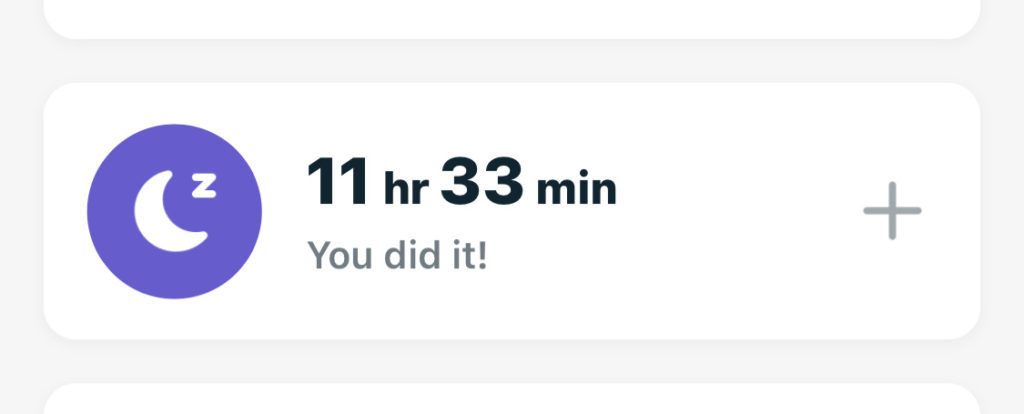
Day 14
I wake up motivated and do 40 minutes of training before I have my coffee. I reward myself with a biscotti and an Americano and quickly learn that my taste buds need time to recover. PoNS kind of numbs them, and it takes a beat to be able to taste again.
Day 19
I show up to physio in vintage 1990’s Adidas tearaway pants, having finally figured out what to wear to maintain my dignity while getting semi-clothed acupuncture, assuming dignity looks like a middle-aged woman dressing for a 90’s rave. (It doesn’t.)
Day 25
Am I getting better at walking after wine? Not like, better, better, but kinda?
Day 49
I test my 25-foot timed walk at home and I’m down to 7.49 seconds. I do it in 9.6 seconds with my cane.
Day 58
Fitbit tells me I took more steps today than I have in 3.5 years. I walked home from dinner on a patio in my hood, where I had two glasses of Chardonnay. I am getting better at walking after wine.
Day 65
I’ve been religiously tracking my daily walks around the block since the trial began. Today I clock 17 minutes, which two months ago would have been impressive. Now it feels slow, except I did it without my Dictus. I’m starting to say “I can’t believe it” a lot.
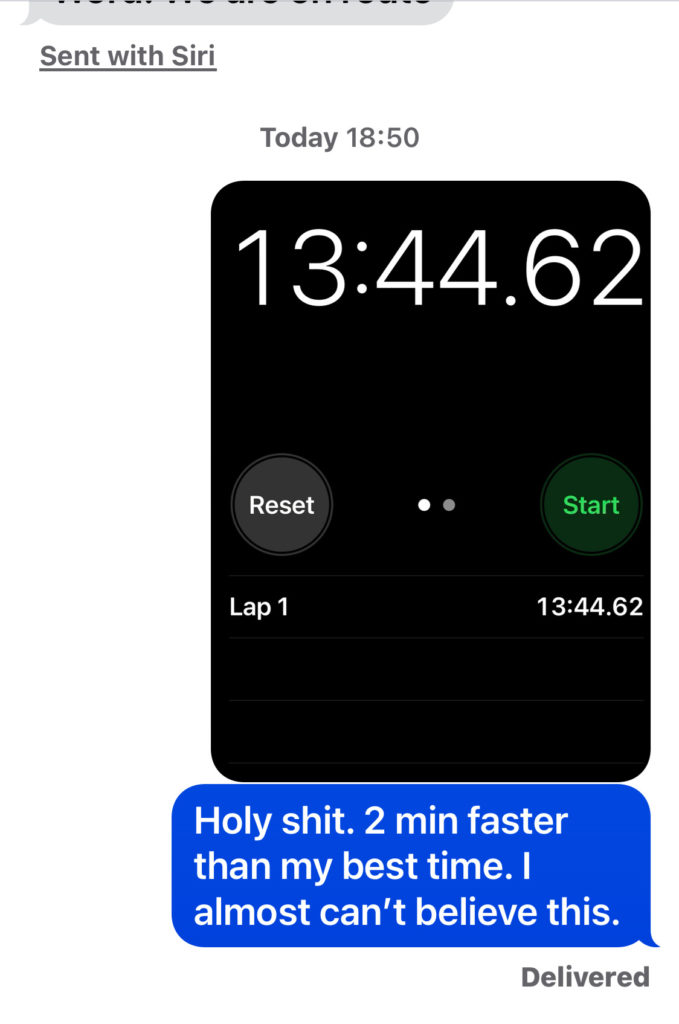
Day 89
It’s my penultimate appointment and we’re supposed to be celebrating my gains, but Christie is charged with yet again telling me that at the end of the year the cost of PoNS will be doubling to ten thousand dollars and the mouthpiece will jump from $500 to $2500 every three months. Is this a PoNS scheme? Like a savvy drug dealer, the first three months are free and once you’re hooked on that sweet, sweet, walking high, they own you?
Christie does some retesting that confirms what we both know: I am stronger and faster:
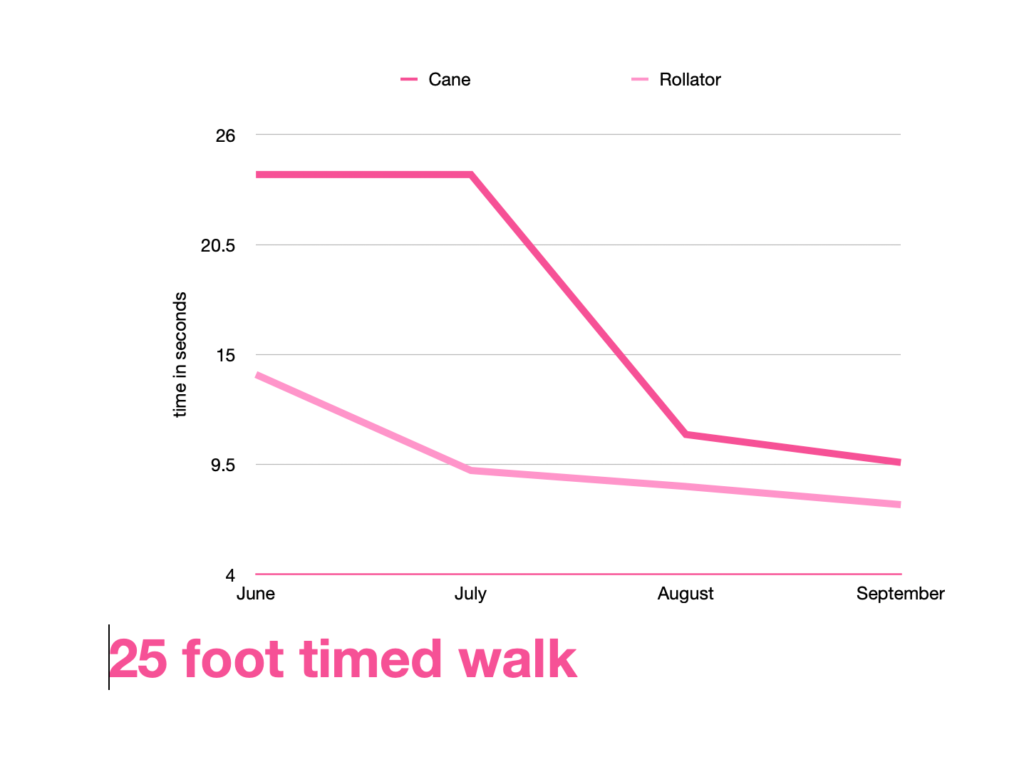
From the safety of my apartment, I’ve started to practice walking without any aids. Drop-foot means my right foot still needs to slide, but I’m able to stay on my feet, unsupported, in intervals of 20 minutes without breaks. I’m prepping meals without needing a chair. I feel safer getting in and out of the murder-tub. Don’t tell The Banker, but I could probably start doing the laundry again.
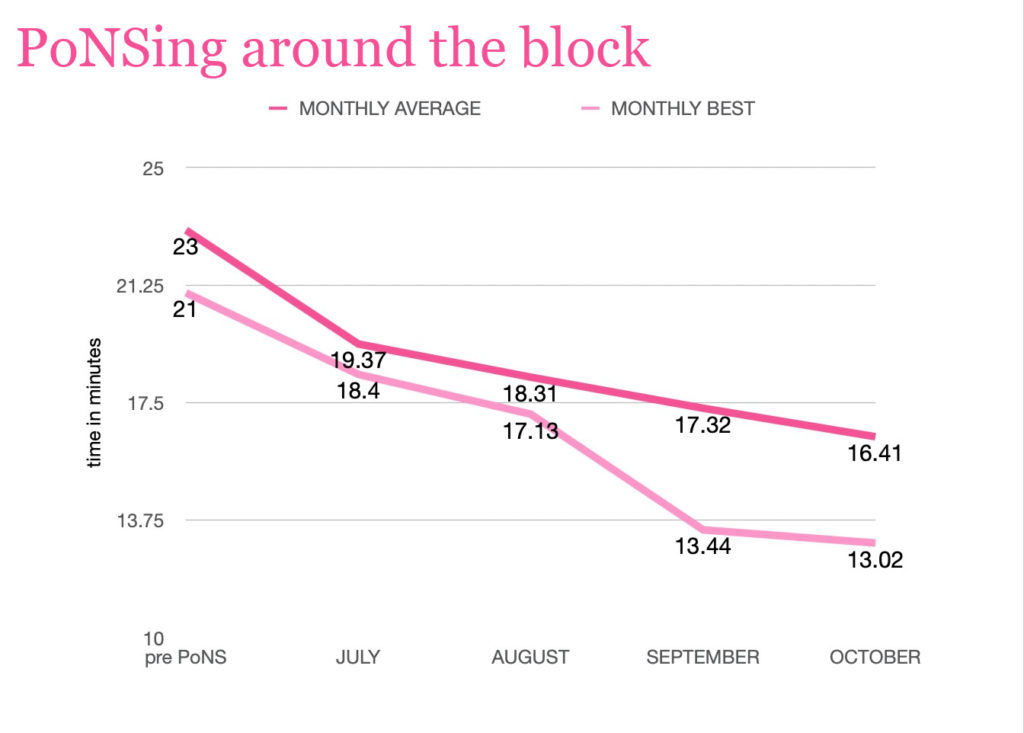
I’ve been watching my body get slower and slower for years. My go-to proposition to the dark arts mostly consists of pleading for things to just stay the same. I’ll be good. Just don’t let me get worse and you can have my first born baby. You can have all my babies. You can have my Prada sunglasses and all my Sephora points. I’ll even stop swearing if you just let me stay the same. I don’t ask for improvement, because even in a deal with the devil, improvement seems like too much to ask; too much to hope for.
PoNS review: can PoNS help MS progression?
If you don’t have MS, you might be wondering what’s the BFD? I still walk with a walker and pee with a catheter. I still very-fucking-much have MS. But if you have MS too, well, I don’t have to explain these results. For the first time in forever, my MS is changing for the better, with the intervention of a device whose only side-effect is that my hair occasionally gets caught in the hard plastic neckband.
So I ask myself, if this is what’s possible in 99 days, what’s possible in the next 99? And the 99 after that? What is possible for the future of my MS?
What are you saying? PoNS improves MS?
More research needs to be done. We all know that everyone’s MS is different. PoNS isn’t about overnight miracles; there’s hard work involved and PoNS isn’t going to do it for you. But there’s reason enough for me to believe PoNS has contributed substantially to my improving mobility.
If you want to know how to get your hands on your own PoNS device you’ll have to do some googling. I’ve reached out to Helius with a number of Qs, but the PoNS pusher who first contacted me—a guy who genuinely seems to care about people with MS—sadly, no longer works for Helius, and my line of communication has been cut off.
Helius has every right to make as much money as they can from their product (yay, capitalism). But, PoNS can change the lives of a few people or it can change the lives of many. While PoNS waits to qualify for the medical device status it deserves, people with progressive MS will continue to wrack up disability. We don’t have the luxury of time on our side.
While I feel very lucky to have participated in this research, as trial participants, we’ve invested considerable time, effort, leaps of faith and the significant cost of intensive physio–investments that will contribute to the eventual approval of PoNS as a medical device.
Helius, you’re not taking my calls, but I know you’re reading this. Please do the right thing and make PoNS available to more people with MS. I urge you to allow your study participants to keep their devices once the data has been collected (a gesture which costs you nothing), and to reconsider your extraordinary cost increase.
I’d love to hear from other PoNS users. Some of you have reached out privately, but if you’re comfortable sharing in the comments, I know others will benefit from your perspective.
I’ve been without PoNS for a couple of weeks now, but I’m not willing to plateau. I set fire to my credit card and invested in the device and a stockpile of as many mouthpieces as I could manage before prices go up at the end of the year. I’ll start PoNSing again, when my new device arrives, and I promise to keep you posted.
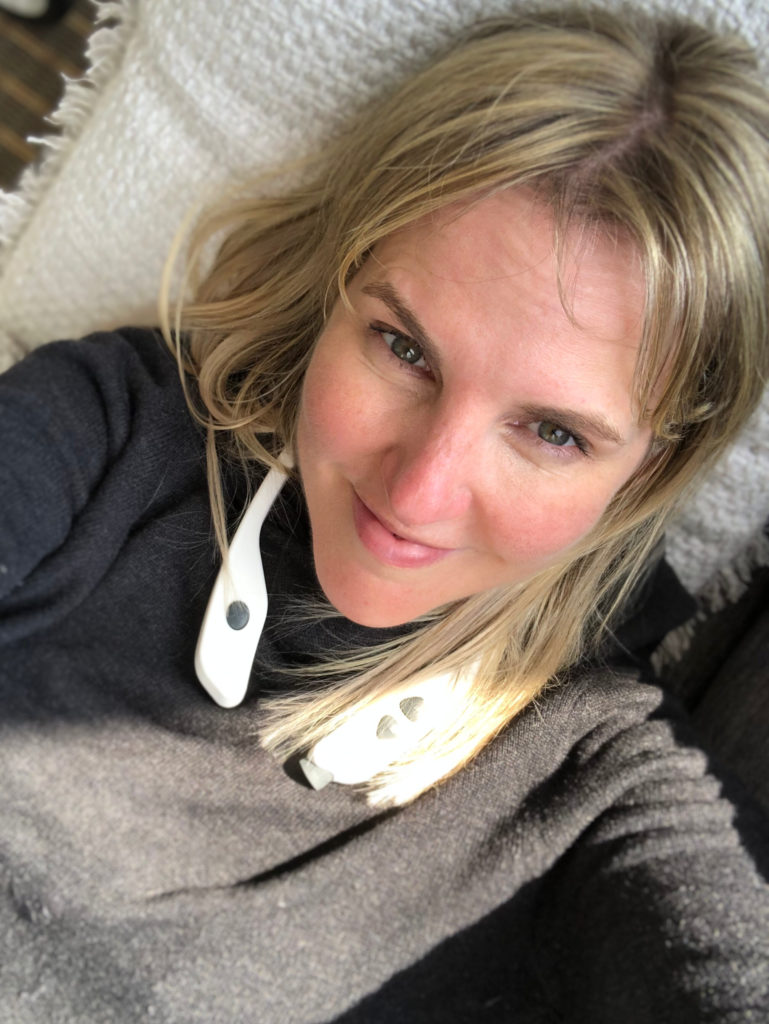
Keep moving, Trippers. There’s hope on the horizon.

Follow Tripping on Air on Facebook and Instagram.

 Back to
Back to
This post demonstrates why ToA is the best MS blog going. I LOL’d I teared up a bit. This much improvement in 3 months seems exceptional, even factoring in intensive physio. I’ve tried to track down PoNS here in the UK, without success. At those prices I won’t be getting it on the ‘nash anytime soon.
All the best.
There are multiple clinical trials happening. Fingers crossed for widespread availability soon.
Love the blog from over here in OZ. I thought Pons was a scam (sounds too much like Ponzi scheme). But your review has restored my faith.
I finally found a drug (Fampyra: Aussie version of Ampyra but sounds more like a vampire drug ) that improved my mobility and showed similar improvements to yours during my month long trial. Now I wait to figure out financing my drug journey without selling a kidney. If I combined it with Pons??????????
I now have something else to google between 500m walks around the block (snap).
No matter how you do it;Walking is still walking
Love
Gav
Thanks for reading! I’ve been taking Fampyra for many years (we call it Fampyra in Canada too). The difference between the drug and the PoNS is that the drug isn’t repairing damage (if you stop the drug your symptoms will return), but the PoNS is creating new neural pathways and those gains are yours to keep.
Please keep me posted if you do end up using PoNS. There are so few of us and I’d love to hear about others’ experience.
Tres Scary!
I’ve been so looking forward to this review!
I wanted so bad to be able to try this back when you started and literally the day or two after you had posted the text screenshot on Instagram I was contacted to ask if I wanted to participate in a clinical research study with the PoNS device!
I started with the PoNS Monday past and have been doing physio with it daily and will continue to do so for 14 weeks. So far, like you, I’m kinda cautiously optimistic. I can definitely stand with my feet closer together — not touching (yet?!) — than I have in years. Small win, but I know you can understand that!
Definitely excited to see how this goes, and I’m very happy you have seen results with the device. Like you though, I am disappointed in the cost of this and know that I am of the very lucky few who are able to try this, and I know that if it wasn’t for this trial it would be quite unlikely I’d be able to try it. From my limited time using it, I already feel that it is something that many more people with MS should be able to avail of.
Please come back and comment here when your trial is done. I’m sure we’d all love to hear how you make out.
It was very helpful for me to keep careful notes on my progress using an app (for distance and speed). It can be hard to notice gradual changes and worsening from one day to the next, but the same is true for improvement. It helps a lot when I have a “bad” day now that I can look back and see I’m still 6 minutes faster than I was on a “good” day 2 months ago.
What app do you use for tracking?
I’m use Runkeeper, since as far as I know there is no Hobblekeeper app.
Excellent post. It’s great to hear of your progress and I appreciate your honesty.
Are you still using PONS?
Congratulations on what can only be described as unbelievable gains in your strength and mobility. Those price increases are a bit shocking though. Sure seems like gouging.
I’ve been waiting for this post, Ardra. I know you are an n of 1 and that the results aren’t yet published. But my neurologist recommended PoNS – you may know her 😉 – and I think maybe, just maybe, I’ll be brave enough to take that leap. Thank you.
Good luck, Erin. The endorsement of a top-neuro is very encouraging.
Please keep us updated!
I wonder if the device is actually doing anything, or if it was just all the extras you were doing and how hard you were working? My neuro says as MSers it is SO much better for us to keep moving, doing etc rather than resting too much etc, and i know I’ve worked hard and am almost but not quite back to normal, with no device. Just skeptical. I like science so i would need to hear from the mayo clinic or something to verify this very costly device.
I was skeptical too. I’ve always exercised and done regular physio, and continued to get worse anyway. I’ve had to comfort myself with the idea that if I wasn’t doing those things I would be getting worse faster.
This feels different. But I understand your skepticism when it comes to promises about MS. Make sure to look for the studies once they’re published.
I’ve been reading about neuroplasticity and PoNS for a while now, so was very eager to read your review. This seems like a game changer for people with MS. I have PPMS and my “walking” is similar to yours..maybe worse. Thank you for this post and for all the honest and highly amusing posts you do! I will be on the lookout for a trial and will be lobbying for healthcare to cover something like this!
Thanks for reading and for your kind words. Keep us posted in your advocacy!
Did you get the impression that maybe this could be covered sometime if they collect enough data?
Yes, I expect that’s the goal–to get it approved as a medical device and then insurance will be on the hook for the cost.
It actually is a Class 2 medical device in Canada and has been since 2018. I know of a couple people that have gotten it covered but it depends on your insurance…. Loved the review and glad for your improvements; my sister has MS so always keeping an eye on your posts!
I’ve been waiting for this post ever since you wrote that you were taking part in a trial. I’m SO delighted that you’ve had great success!
I talked to my neurologist about PoNS when I saw her three weeks ago. She told me that it’s outlandishly expensive (which I knew already) and that, so far, the science isn’t there. Progress, she says, is likely from placebo (I’m a huge fan of placebo, though, so I see this as a win) and from the enormous amount of physiotherapy involved. That got to me: physiotherapy. I’ve been dismayed that my MS clinic offers visits with the physiotherapist every 3-4 months and that her aim is to maintain current function, not to improve anything. She seems to think that SPMS means no improvement is likely.
So I found physiotherapy clinic here in Vancouver that specializes in working with people with neurological problems, specifically MS, Parkinsons, TBI and stroke recovery. Treatment there isn’t cheap, either. But I decided I could afford $144 a session for awhile. And so I had my first appointment on Thursday. I’ve never had such a complete examination and assessment. I had no idea that two of my toes on each foot are too close together when I walk and that’s a problem, for example. I told the therapist that I want an intensive program that I can work at on my own, with frequent follow-up evaluations and ongoing modifications until we have a true picture of what I am and am not able to achieve.
My own walking looks more normal than yours does, but I don’t have drop foot, which is probably the reason. I use a rollator when I’m out of our condo, but don’t need it inside. I’m not at all sure what’s reasonable to expect, but I’m going to do my best to get all the exercise and targetted therapy possible and hope for good results.
Thanks for writing about this, Ardra. I’ll keep track of my progress, too, and see what happens.
Good for you for advocating for yourself. There aren’t nearly enough resources for ppl with SPMS and it’s beyond disappointing when even our HCP’s don’t have any hope for improvement.
There are a number of clinical studies happening with PoNS. The one I’m involved in is through the Barlo Centre at St Mike’s MS clinic in Toronto. Hopefully it will yield enough scientific data to convince your neuro. In the meantime keep making shit happen.
I am thrilled that you are showing improvement. I am listening to some drunken guys singing outside my window and assume that is because they are celebrating your progress. Or it could just be the practice at midnight in King’s Cross, London. Keep at it Ardra. Soccer ⚽️ is what the drunken guys love and their singing will double when you score off a penalty for the Toronto Argonauts.
P.S. Now there’s some drunk women singing.
Thanks, Joe. Say hi to Ted Lasso.
I felt so happy for you that I read your post again. I loved every profanity and wish you had used more.
Well, shit. Thanks Joe.
I am thrilled for you Audra! Eagerly Looking forward to your future posts.
I have been in touch with the Neuroplasticity clinic in Surrey, BC. I have a contact in Prince George who has the device and has also seen improvements. My husband was quite leery about the whole situation., we were actually planning a call to her to find out what her before & after looks like! Then life got in the way. My right side is my problem side too..:( although I could give my left side a run for its money. lol ?
Dear My Hero,
I follow you on FB & Instagram. I only have RRMS & now SPMS. You have thankfully stolen any whining I may have of complaining personally. Your strength is amazing. Reading this chapter in your life is special. Doing my exercise this morning I pretend I’m dancing although my Apple watch doesn’t recognize that.
I wish you all the best I can give & “love” from a special place in my heart.
Ardra, thank you for this update. I’m diving into PT (physio) this week and feeling my cautiously optimistic side coming forward along with the cynical bitch that dismisses all of it rolling her eyes while sucking down a clove cigarette in the corner. I *hate* that these people wouldn’t let you keep the device.
Cautiously optimistic with a healthy balance of cynical bitch sounds like the best approach to a disease like MS (and life in general). Good luck with your PT. One thing I know for sure is that we have to keep moving.
Way out of my league money wise so I’ll continue with glatect ..I’m not sure if it helps but I’ll continue just in case…keep up the struggle ???for all of your ms family..thanks for your fight???love ya???
Excellent news on P0NS results. I’ve been looking forward to your/this post. Why is it so damn expensive to be disabled?! It’s not an elective ffs!
Keep it classy Ardra✌?
Right?! MS is bougie af.
Perhaps I can offer some support for those of you interested in PoNS. My name is Tom, and I’ve spent most of my adult life in various aspects of the broad field known as natural medicine. I’m not a MS sufferer and my heart goes out to all of you dealing with this devastating chronic illness. I’ve published research on the treatment of chronic migraine so I have some connection to chronic neurological conditions.
Modern medicine is the study and treatment of the body’s biochemistry. Pharmaceutical interventions are attempts to help the body via modification and/or manipulation of its biochemistry.
Without doubt the most exciting innovations I’ve seen in the last 30 years are those that diagnose and/or treat the body by addressing the body’s biophysics. The biophysics of the body are its ability to generate and utilize energy. The science behind PoNS and other devices that are out there or are coming is quantum physics.
Those who attribute these devices abilities to placebo are likely unfamiliar with the potential that quantum physics offers to many suffering chronic illness, particularly neurological chronic illness.
I’ve had the opportunity on several occasions to chat with one of the inventors of the PoNS device and the science and potential are solid. The applications go beyond MS but every company needs to start somewhere.
I share your frustration with the projected cost of the device. I will remind all that when LASIK eye surgery was initially offered it was like $15,000 per eye. Today the surgery is often available for $1,000 per eye. Those who can afford to try the PoNS, please for the sake of others, take the dive. Hopefully the time will soon come when insurance covers the treatment or the cost becomes more reasonable.
You are all aware of the limitations of the pharmaceutical approach to health and wellness. Various drugs can delay progression and sometimes improve quality of life but they are not curative. PoNS is opening a new door in treatment as it seems to stimulate the body’s homeostatic energy.
I have no financial interest in Helius or PoNS. My passion is seeing our healthcare system evolve beyond its excessive reliance on drugs and surgery. I’m happy to answer any questions y’all may have.
Ardra, thank you for your courage and determination. One last thought to share. PoNS seems effective in stimulating the body’s ability to generate neuroplasicity. As with any tissue repair or rebuilding, biochemistry comes into play. Keeping your nutrient intake as clean and healthy as possible gives the human organism the pieces it needs to respond to the direction the PoNS is providing.
Best,
Tom
Amazing News! Thanks for the update. Looking forward to the new fashion show you’re working on, too.
Thanks Sandra! Stay tuned!
Thank you so much for this post Ardra. These real life experiences with new MS treatments mean a lot to so many people. You are a good human. Thank you. I really enjoyed reading.
I hope you have a great halloween.
Ardra thank you for taking the time to post your PoNS experience. I was anxiously awaiting your review. I’m so happy for you. My question is do you need to use it all the time or only a certain amount of time per day?? I’m sad that it’s so expensive because how many ppl will actually be able to afford one. It seems so unfair.
I go to the MS Tisch Center in Manhattan and will be asking my neurologist about this.
I think the general recommendation is to use it about an hour a day. I used it a bit more than this but I took days off too. I think the more you use it the better/faster you will have results.
I get my new device tomorrow and I plan to use it as much as possible. Doing laundry or cooking dinner require balance and stamina and are opportunities to create new neuro-pathways in a way that doesn’t feel like physio (but totally is). I plan to get my money’s worth and just have it on as much as possible. There are no side effects.
Good luck at Tisch. I haven’t been there since the Before Times. I’ll have to send Dr Williams a note about how PoNS has helped me.
Hi Ardra, thanks for the detailed recap. I’m curious, do you have any other deficits like issues with your hands/arms/posture? If yes, did you see any improvement in those areas or were you guys only concentrating on gait? Walking speed is A good metric for quantifying improvement, but it seems like if this is based on neuroplasticity, it should be able to improve other kind of motion. Opens up a whole universe of possibility… At least were it not for the obscene price tag.
Yes, I noticed a number of improvements in my balance and stamina in general. I feel less impacted by heat and alcohol. My walking was the easiest metric for me to quantify. It’s one thing to say I feel better and stronger and like I can do more, but I need to see it in hard numbers to really believe it myself.
Dayum, Ardra, why have I not found your blog until now? I’m in the US, hoping very much that PoNS therapy will be available here soon — it’s been approved, but isn’t actually being offered until spring, according to the Helius person I tracked down and backed into a corner. Please keep letting us know if you’re still using it and how you’re doing.
All sounds so promising….but the cost is fucking ridiculous! I’m in the US and thus far we are getting gouged by the pharmaceutical companies who make an insane profit (shame on you) and now potential hope on the market and you gouge us again!! We are disabled, not millionaires. Prevention is more cost effective , always.
Thanks so much for sharing!! Agree we have to keep on moving anyway we can…also believe in electrical stimulation for MSer’s have the original Walkaide it requires its user to alter wardrobes,but works (needs some tweaking). Also use a FES {Functional Electrical Stimulation} bike at the gym that really has promising effects!! It also fills in the gaps to transfer messages through our pathways where MSer’s are absent of that neurological communication.
Researchers should always speak and work with its users on these or any future products because WE Know From Experience what good and bad challenges we face with these items use. Its not enough to create but actually use in real life!!! Prevention is always more cost effective!!! Don’t you get it?
I just heard about the PoNS device last week, after it received FDA approval in the US, and immediately began envisioning myself as I used to be – running up and down stairs, driving again, chasing after grandchildren… I read the article, visited the Helius website,
and reached out to Helius to get more information…and I’m still waiting to hear back from them. ?
I’m so glad you were able to share your experience with the device. I’m long past the cane stage. I’m using either walker, rollator, power scooter or power wheelchair, depending on the situation. I’m also on dalfampridine (generic Ampyra), but it doesn’t have me running marathons (not that I ever did, but just the thought makes me hopeful). Other than the potential of what stem cell therapy might provide (not approved and really expensive), this might be my only hope to return to some semblance of walking normalcy. It’s too bad the costs are so high, but maybe now that it has FDA approval, Medicare should help fray some of the costs. Thanks again for sharing.
Correcting my website address: https://shaydee5.wordpress.com/
I’ve known of the PoNS unit since 2015 from reading Normand Doidge’s second book. I actually called the U of WI in Madison where it was being developed.
I watched with glee the success that Montel Williams had with the devise and he was allowed to keep the unit.
Many clinics in Russia were using it and Uri Danilov was involved with these clinics.
Then PoNs was sold to Hellius and the company went public with the initial stock price around $6.00. It quickly fell and am not sure where it is today. Anyway the company needed to make money, they had a celebrity promoting it and they were using it on TBI @ Walter Reed Medical Car with success. But only Canada would license it.
Two or 4 years ago the cost was $30,000.00 for 12 week use and beginning weeks included intense physical therapy. No insurance was covering that cost even in the 2 or 3 clinics in Canada.
The price keeps increasing and their ability to truly help the disabled has been lost as the value of their stock tanked.
I do not have MS but some other neurological problem that no one understands. I am addressing my balance and walking difficulties with a neuro ophthalmologist and with a cognitive therapist Dr. Donalee Markus. There are many ways to restore neuro pathways and PoNs is not the be all end all.
Unless you have a lot of money I encourage you to look elsewhere for help and hope. Hellius has their bottom line to meet. Who thinks there is a justification to go from $500.00 to $2500.00 for a mouth piece. Even with inflation this increase is un defendable.
And if you have not yet read Dr. Normand Doidge, do. He has 2 books about the brain and talks about many therapies. My D.O. recently informed me he has a new book due out in November.
Keep moving and searching. The elusive PoNs is cost available to only a select few and believe me accepting Medicare or any other insurance reimbursement will never happen. Oh did I mention I was a medical biller for 20 years. It is a game.
Medicine as we know it wants your $ and not to loose you as a cured unchangeable customer.
Best healing thoughts.
Keep it real.
Thanks for sharing your experience. I am just starting week 11. I had to stop 10 days because I’m just getting over covid. Hopefully I can get back to feeling stronger soon.?
Holy Sh*t!! You are so awesome!! Thank you so much for sharing and you commitment to keep up with the updates (I would REALLY want to, but not sure my commitment meter goes that far!!) I live in the US and am going to be turning to my girl (Google) for info.
Again, thank you!!
Thanks so much for this Ardra. I’ve had PPMS for 10 yr (60 yr old male) – poor gait, balance, strength, stamina, but still hobbling around with a cane. My right side is also the worst and I drag my right foot around.
I found you via http://www.stuffthatworks.health (also recommended). I first read about PoNS through the Norman Doige book, but it wasn’t available yet. I’m in BC and see I can now sign up through a clinic. Very pricey, but way less than HSCT and safer, so I have an intake appointment mid-July. I’ll post more later if I take the plunge.
Hi Gavin,
Thanks for reaching out. I hope you can swing this treatment and that it benefits you. Thanks for keeping me updated and good luck!
Love, love, love your post and your honest appraisal. I am a physio who is lucky to have access to the PONS in my clinic and I have witnessed so many beautiful stories like yours. I find myself in happy tears with families more often this past 3 years than I ever have in my 30 year career. I am advocating hard for the prices to get better and I can tell you that over the last 3 years, they have dropped considerably, and I anticipate that they will gradually continue to come down as more PONS units get out into the world. In addition to offering payment over a 3 month period, we have also secured a financing company who can extend a loan over up to 60 months for those who need the device and struggle with the financial aspects. Given what I’ve seen and experienced with my clients, I am 100% committed to helping more people get access to this important technology. Thanks for spreading the word!
I just started this therapy!
My neurologist, thought I would be a good candidate for a clinical trial and when he suggested it to me, he was surprised to learn I was already familiar with it. I told him that I follow a blogger in Canada, and I was excited to have the opportunity to participate in this clinical trial finally here in the US!
So exciting! Please keep us posted as to how you make out!
Curious if you’ve continued to have improvements – it sounds like you purchased a pons and the mouthpiece after the trial.
I too am curious to know if you have continued with the poNs Therapy. There is finally a clinic in Manitoba that is offering it. I have SPMS but lately my right leg does move unless my husband is supporting me and pushing my foot to take a step. The cost of this may deter me from trying this out.
PonS works but it is very expensive and requires a real commitment to physiotherapy. I haven’t used the device in many months now. I believe in it and would like to start using it again but I need to first re-establish a new physiotherapy routine. (I need to get my shit together)